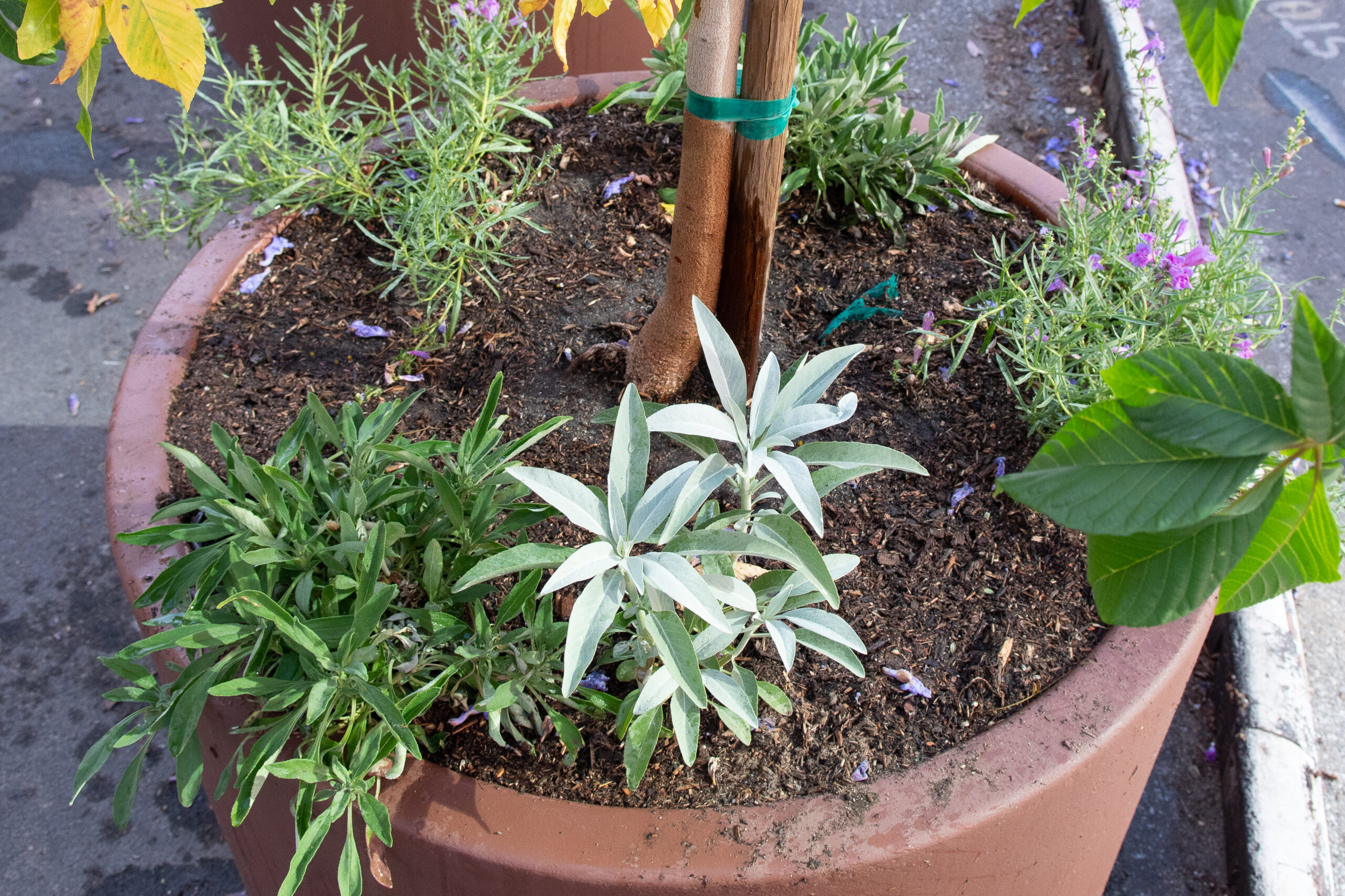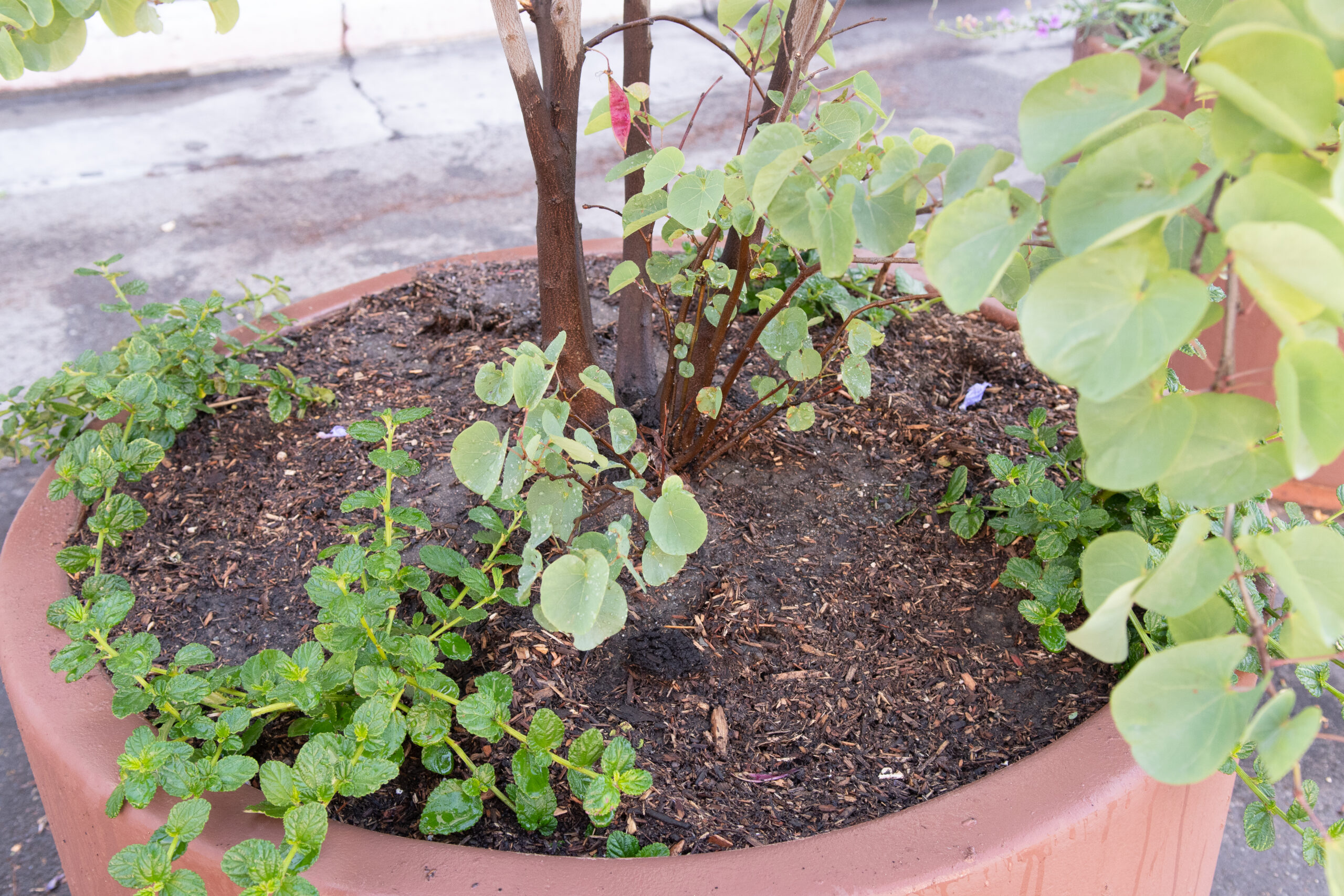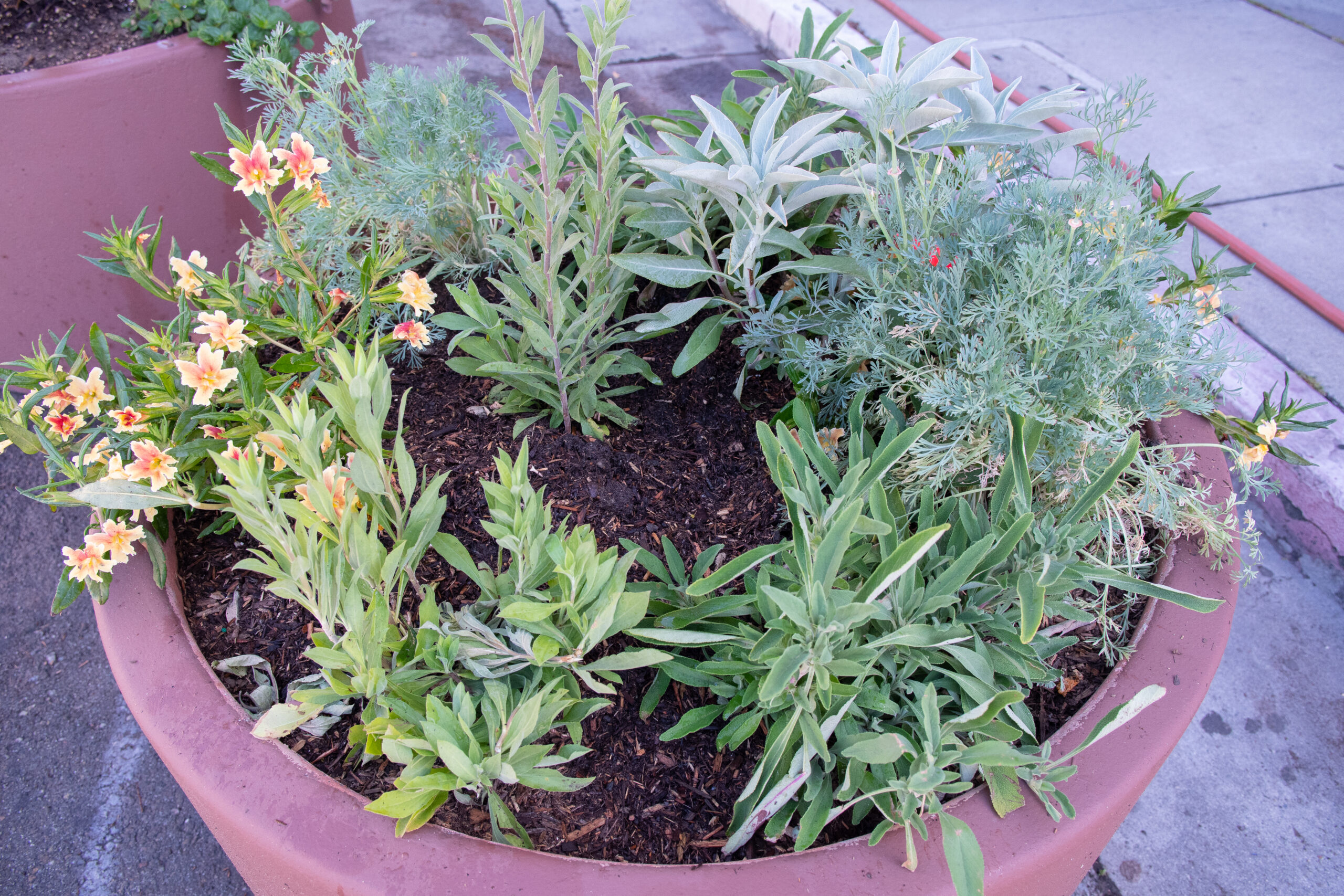SoFA Urban Garden
Located at 396 South First Street
California Chaparral
Foothill Penstemon
Scientific Name: Penstemon heterophyllus
Native Habitat: Found only in California in coastal and northern Sierra mountain ranges.
The Foothill Penstemon is a shrub found in multiple ecosystems ranging from grassland, chaparral, woodland, and forest. It produces clusters of tubular flowers that come in blue, purple, or magenta colors. The flowers attract a wide variety of pollinators, especially bees and bloom in the winter, spring, and summer.
White Sage
Scientific Name: Salvia apiana
Native Habitat: Coastal sage scrub habitat of Southern California and Baja California.
White Sage is most known for the strong aromas in its leaves. The leaves are thick, and covered in hairs that trigger oil glands when rubbed. Its flowers support a wide variety of pollinators, making it an important plant in the coastal sage scrub habitat.
Dara’s Choice Sage
Scientific Name: Salvia clevelandii ‘Dara’s Choice’
Native Habitat: California chaparral regions
Dara’s Choice Sage is a fast growing drought tolerant plant that blooms in the spring and summer. The lavender colored flowers also produce a pleasant fragrance, and look dramatic with its dark green background. This makes Dara’s Choice Sage attractive to many pollinators that include hummingbirds, butterflies, and other insects.
California Buckeye
Scientific Name: Aesculus californica
Native Habitat: Found only in California in oak woodlands, foothills, and coast ranges.
The California Buckeye is a small tree that is very drought tolerant. It loses its leaves in both the summer and winter. The flowers grow in a cone, and are white in color. Insect pollinators are attracted to the flowers, and are an important source of nectar for migrant butterflies in late spring.

Western Redbud
Scientific Name: Cercis occidentalis
Native Habitat: Dry slopes and foothills from northern California to Utah and Arizona below 4,000 ft.
The Western Redbud is a pollinator’s delight. Its bright pink flowers bloom from March to May, and are an important nectar source for bees, hummingbirds, and butterflies. Some native bees also use its leaves to build nests inside trees. The Western Redbud is great for drought tolerant gardens and beautiful during all seasons.
Wild Strawberry
Scientific Name: Fragaria vesca
Native Habitat: Grows naturally throughout much of the Northern Hemisphere. Can be found in forests, woodlands, and meadows.
-
- The Wild Strawberry is known for its edible fruit. The fruit is strongly flavored, and has been used by humans since the Stone Age. Ungulates like deer and elk eat the leaves. A variety of mammals and birds also eat the fruit and disperses its seeds. The modern day strawberry in grocery stores is a hybrid that shares many of the same genetics as the Wild Strawberry.

California Poppy
Scientific Name: Eschscholzia californica
Native Habitat: includes California and extends to Oregon, Washington, Nevada, Arizona, New Mexico, Sonora and northwest Baja California
The California Poppy is an iconic flower in the American West. It became California’s state flower in 1903, and its image can be found here in SoFA District on the California Theater’s light sign. California poppies bloom between February and September, and its flowers only open during the day time. At night or during cold weather, the flowers close up. California poppies are also drought tolerant, self seeding, and easy to cultivate in any garden.
California Fuchsia
Scientific Name: Epilobium canum
Native Habitat: Dry slopes and chaparral regions of western North America, mostly in California from 1,600-9,800 feet above sea level.
The California Fuchsia produces red trumpet shaped flowers that support a variety of pollinators. It blooms in the summer and fall with little water needed. This plant is also used as ground cover in pollinator and drought tolerant gardens.
California Goldenrod
Scientific Name: Solidago velutina californica
Native Habitat: Found in oak woodlands all over California.
California Goldenrod is a native herb that produces masses of yellow flowers that flower during the summer and fall. Pollinators love this plant. In the garden, California Goldenrod is drought tolerant and fast growing.
Dara’s Choice Sage
Scientific Name: Salvia clevelandii ‘Dara’s Choice’
Native Habitat: California chaparral regions
Dara’s Choice Sage is a fast growing drought tolerant plant that blooms in the spring and summer. The lavender colored flowers also produce a pleasant fragrance, and look dramatic with its dark green background. This makes Dara’s Choice Sage attractive to many pollinators that include hummingbirds, butterflies, and other insects.
Lewis’ Monkey Flower
Scientific Name: Mimulus lewisii
Native Habitat: Western North America from Alaska to California and Colorado. Can be found at streambanks 4,000 to 10,000 ft above sea level.
This flower was named in honor of American explorer Meriwether Lewis, and is an important flower for pollinators in the Sierra Nevadas. It prefers rich soil and is a common flower to use in pollinator gardens.
White Sage
Scientific Name: Salvia apiana
Native Habitat: Coastal sage scrub habitat of Southern California and Baja California.
White Sage is most known for the strong aromas in its leaves. The leaves are thick, and covered in hairs that trigger oil glands when rubbed. Its flowers support a wide variety of pollinators, making it an important plant in the coastal sage scrub habitat.

California Poppy
Scientific Name: Eschscholzia californica
Native Habitat: includes California and extends to Oregon, Washington, Nevada, Arizona, New Mexico, Sonora and northwest Baja California
The California Poppy is an iconic flower in the American West. It became California’s state flower in 1903, and its image can be found here in SoFA District on the California Theater’s light sign. California poppies bloom between February and September, and its flowers only open during the day time. At night or during cold weather, the flowers close up. California poppies are also drought tolerant, self seeding, and easy to cultivate in any garden.
Red Buckwheat
Scientific Name: Eriogonum grande rubescens
Native Habitat: Found only in the Channel Islands in Southern California.
Red Buckwheat is a mat-forming plant that produces clusters of red flowers on top. This is a rare island plant, and grows on the dry cliffs of the Channel Islands.
Farewell to Spring
Scientific Name: Clarkia amoena ‘Aurora’
Native Habitat: Found along coastal hills and mountains from British Columbia to northern California
Farewell to Spring is a drought resistant plant that blooms in the late spring. It prefers to grow tall and the herb creates beautiful pink and peach colored flowers at the tops. This is a perfect addition to any pollinator garden.
Lewis’ Monkey Flower
Scientific Name: Mimulus lewisii
Native Habitat: Western North America from Alaska to California and Colorado. Can be found at streambanks 4,000 to 10,000 ft above sea level.
This flower was named in honor of American explorer Meriwether Lewis, and is an important flower for pollinators in the Sierra Nevadas. It prefers rich soil and is a common flower to use in pollinator gardens.

Lewis’ Monkey Flower
Scientific Name: Mimulus lewisii
Native Habitat: Western North America from Alaska to California and Colorado. Can be found at streambanks 4,000 to 10,000 ft above sea level.
This flower was named in honor of American explorer Meriwether Lewis, and is an important flower for pollinators in the Sierra Nevadas. It prefers rich soil and is a common flower to use in pollinator gardens.
Dara’s Choice Sage
Scientific Name: Salvia clevelandii ‘Dara’s Choice’
Native Habitat: California chaparral regions
Dara’s Choice Sage is a fast growing drought tolerant plant that blooms in the spring and summer. The lavender colored flowers also produce a pleasant fragrance, and look dramatic with its dark green background. This makes Dara’s Choice Sage attractive to many pollinators that include hummingbirds, butterflies, and other insects.
Western Redbud
Scientific Name: Cercis occidentalis
Native Habitat: Dry slopes and foothills from northern California to Utah and Arizona below 4,000 ft.
The Western Redbud is a pollinator’s delight. Its bright pink flowers bloom from March to May, and are an important nectar source for bees, hummingbirds, and butterflies. Some native bees also use its leaves to build nests inside trees. The Western Redbud is great for drought tolerant gardens and beautiful during all seasons.
Naked Buckwheat
Scientific Name: Eriogonum nudum ‘Ella Nelson’s’
Native Habitat: Found all over California in dry and sunny areas.
The Naked Buckwheat is extremely drought tolerant, and does well in fully exposed sun. Its yellow, pink, and white flowers are an important source of nectar for many pollinators. The plant’s name comes from the naked stem that has no leaves.
Emerald Carpet Manzanita
ScientificName: Arctostaphylos ‘Emerald Carpet’
Native Habitat: Found only in gardens. This plant was cultivated in a nursery from two manzanitas species.
This ground cover plant is popular in commercial landscaping because of its drought tolerant properties and is green year round.
California Fuchsia
Scientific Name: Epilobium canum
Native Habitat: Dry slopes and chaparral regions of western North America, mostly in California from 1,600-9,800 feet above sea level.
The California Fuchsia produces red trumpet shaped flowers that support a variety of pollinators. It blooms in the summer and fall with little water needed. This plant is also used as ground cover in pollinator and drought tolerant gardens.
California Goldenrod
Scientific Name: Solidago velutina californica
Native Habitat: Found in oak woodlands all over California.
California Goldenrod is a native herb that produces masses of yellow flowers that flower during the summer and fall. Pollinators love this plant. In the garden, California Goldenrod is drought tolerant and fast growing.
California Buckeye
Scientific Name: Aesculus californica
Native Habitat: Found only in California in oak woodlands, foothills, and coast ranges.
The California Buckeye is a small tree that is very drought tolerant. It loses its leaves in both the summer and winter. The flowers grow in a cone, and are white in color. Insect pollinators are attracted to the flowers, and are an important source of nectar for migrant butterflies in late spring.
Red Buckwheat
Scientific Name: Eriogonum grande rubescens
Native Habitat: Found only in the Channel Islands in Southern California.
Red Buckwheat is a mat forming plant that produces clusters of red flowers on top. This is a rare island plant, and grows on the dry cliffs of the Channel Islands.
Baby Black Eyes
Scientific Name: Nemophila menziesii ‘Penny Black’
Native Habitat: Found all over California in canyons, meadows, and grassy places.
This plant is a variation of the Baby Blue Eyes. The difference is in the color of the leaves. Baby Black Eyes is a nursery variation that has dark purple flowers, compared to the ones found in the wild that have light blue flowers.
Foothill Penstemon
Scientific Name: Penstemon heterophyllus
Native Habitat: Found only in California in coastal and northern Sierra mountain ranges.
The Foothill Penstemon is a shrub found in multiple ecosystems ranging from grassland, chaparral, woodland, and forest. It produces clusters of tubular flowers that come in blue, purple, or magenta colors. The flowers attract a wide variety of pollinators, especially bees and bloom in the winter, spring, and summer.
White Sage
Scientific Name: Salvia apiana
Native Habitat: Coastal sage scrub habitat of Southern California and Baja California.
White Sage is most known for the strong aromas in its leaves. The leaves are thick, and covered in hairs that trigger oil glands when rubbed. Its flowers support a wide variety of pollinators, making it an important plant in the coastal sage scrub habitat.
California Poppy
Scientific Name: Eschscholzia californica
Native Habitat: Includes California and extends to Oregon, Washington, Nevada, Arizona, New Mexico, Sonora and northwest Baja California
The California Poppy is an iconic flower in the American West. It became California’s state flower in 1903, and its image can be found here in SoFA District on the California Theater’s light sign. California poppies bloom between February and September, and its flowers only open during the day time. At night or during cold weather, the flowers close up. California poppies are also drought tolerant, self seeding, and easy to cultivate in any garden.
Red Ribbons
Scientific Name: Clarkia concinna
Native Habitat: Found along the California’s northern coast ranges from Santa Clara County to Humboldt County
The Red Ribbons wildflower comes in multiple shades of red, purple, and pink. The flower contains a looping pattern that resembles the shape of a tied ribbon. Red Ribbons do not require much water and prefer to live in dry foothills and mountains, which makes it a valuable addition to any drought tolerant garden.
Farewell to Spring
Scientific Name: Clarkia amoena ‘Aurora’
Native Habitat: Found along coastal hills and mountains from British Columbia to northern California
Farewell to Spring is a drought resistant plant that blooms in the late spring. It prefers to grow tall and the herb creates beautiful pink and peach colored flowers at the tops. This is a perfect addition to any pollinator garden.
Planter Themes
Redwood Forest
California Wetland
Oak Woodland
California Chaparral
California Grassland
Coastal Sage Scrub
DID YOU ENJOY THIS EXPERIENCE?
Let us know in this survey
HOW ARE THE PLANTS DOING?
Submit a maintenance request







